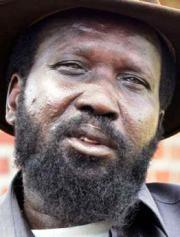Garang successor faces huge challenge
KHARTOUM, Aug 8 (AFP) — Salva Kiir was to be sworn in as Sudan’s first vice president Tuesday, facing the mammoth tasks of carrying on the legacy of his charismatic predecessor John Garang and implementing a precarious peace agreement.
 One of the first challenges for Kiir, the former southern rebel military chief, will be to form a national unity government with former arch-foe President Omar al-Beshir — a process interrupted by the death of Garang in a helicopter crash on July 30.
One of the first challenges for Kiir, the former southern rebel military chief, will be to form a national unity government with former arch-foe President Omar al-Beshir — a process interrupted by the death of Garang in a helicopter crash on July 30.
The reconciliation cabinet and an autonomous government in south Sudan were due to be installed by August 9, in line with a January peace deal that ended 21 years of north-south war in which two million people died.
Kiir, who also succeeded Garang as chief of the former southern rebel Sudan People’s Liberation Movement (SPLM), will have to help solve disputes surrounding oil-rich areas on the north-south border.
He will also have to continue talks led by the late Garang with several Khartoum-backed southern militia chiefs with a view to rallying them to the peace agreement.
Kiir has pledged to continue in Garang’s footsteps and carry on his dream for a democratic and prosperous Sudan, which does not discriminate against citizens on the basis of race, creed, gender or ethnicity.
“I say it loud and clear that the SPLM is a vehicle with no reverse gear,” Kiir said in a speech during Garang’s funeral ceremony last Saturday. “I reiterate my commitment to the implementation of all the clauses of the (peace deal),” he promised.
The United States, which invested much political capital into securing the January 9 pact, has expressed confidence in the SPLM and Kiir’s ability to uphold the deal.
“They have intellect, a track record, and modes of resolving problems internally and a mighty deal,” US special representative for Sudan Roger Winter said while in Sudan for Garang’s funeral.
Fears about the future of the peace deal were sparked in the immediate aftermath of Garang’s death when 130 people were killed in apparent inter-communal rioting between northeners and southeners.
UN special envoy in Sudan Jan Pronk has urged Kiir to push for a quick resolution of territorial quarrelling over oil-rich areas in central Sudan.
“The problem is not in the north or south. The problem in on the fringes of central Sudan,” he has said.
Pronk was asked by Beshir to help mediate the dispute, particularly between the Arab Misariyah and African Dinka Ngok tribes over ownership of territory in the oil-rich Abyei region.
The Misariyah have rejected the boundaries proposed by an international commission for the district while the Dinka — to which Kiir belongs — insisted the area was part of south Sudan.
At any rate and until a 2011 referendum on secession is held in line with the peace deal, oil wealth is to be shared and concessions awarded by a joint oil commission. Most oil fields lie in the south.
Southern residents will be asked at the end of a six-year period whether they want to secede from the north.
In the case of Abyei and two other disputed districts — the Nuba mountains and the southern Blue Nile — both northerners and southerners will vote in a separate referendum on their future status.
But while Kiir may have much on his plate, important aspects of the peace deal were already implemented during Garang’s life.
These include the enforcement of a permanent ceasefire and the drafting and ratification of a six-year interim constitution for the country.
During the four first years of the interim period and until general elections are held, Beshir’s National Congress Party will have 52 percent of executive posts and legislative seats and the SPLM 28 percent.
Fourteen out of the remaining 20 percent will go to northern opposition parties, with the remaining six percent to be split among other southern groups.
Officials said they expected Kiir’s swearing in ceremony to be modest compared to that of Garang, which was attended by a host of international dignitaries and regional leaders.
